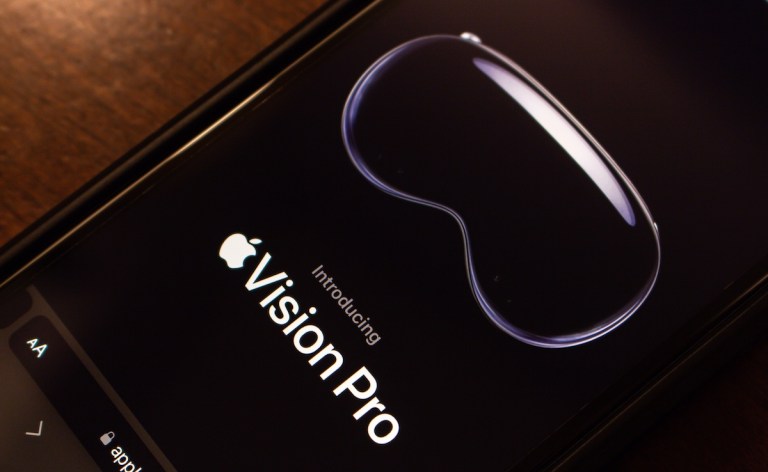
Mixed-reality technology is reshaping the landscape of the retail industry, ushering in an era of immersive experiences for consumers that blend the digital and physical.
Apple released its first mixed-reality headset, Vision Pro, with 600 new apps and games Friday (Feb. 2). Among these were forays into augmented reality (AR) and virtual reality (VR) from major retailers, taking advantage of the capacity to offer consumers more interactive eCommerce journeys.
Take, for instance, major apparel retailer J.Crew. The company announced Friday the debut of its “J.Crew Virtual Closet” app, developed in collaboration with immersive shopping technology company Obsess. The Vision Pro app presents headset users with a 3D shopping experience, enabling them to peruse products and assemble outfits. Additionally, the integration of the Apple SharePlay feature for FaceTime video calls enables the retailer to provide real-time advice from stylists in this lifelike environment.
“The J.Crew Virtual Closet is a first for the fashion industry — leveraging Apple’s newest technology to immerse shoppers in a hyper-realistic styling experience with our brand,” Halsey Anderson, vice president of marketing at J.Crew., said in a statement “We’re thrilled to continue our partnership with Obsess to use this cutting-edge device to bring J.Crew into an exciting new era of spatial shopping and styling.”
Meanwhile, beauty brand e.l.f. Cosmetics introduced Friday the “your best e.l.f.“ visionOS app on Apple Vision Pro, also created with Obsess, encompassing 3D product integration, guided meditations, interactive games and streamlined shopping through Apple Pay. The app is meant to “contextualize an assortment” of the brand’s products, enabling e.l.f. greater control over how its products are experienced on digital channels, much the way a brand can curate an in-store experience in its physical spaces.
In the realm of sports entertainment, MLB launched its own Apple Vision Pro app. The offering includes interactive statistics, play-by-play analysis, and advanced data visualizations, in addition to the option for consumers to view the game through a “digitally rendered MLB ballpark.”
“[F]ans can transform their space into a Major League ballpark and surround themselves in a rich, spatial experience that was previously impossible, all while enjoying a more immersive viewing experience,” Noah Garden, the MLB’s deputy commissioner, said in a statement.
Home improvement chain Lowe’s, meanwhile, launched its Lowe’s Style Studio for the headset, a VR tool that enables consumers to design their dream kitchen with preset options, customizable materials, and a range of fixtures and appliances, employing a user interface driven by eye and hand gestures.
“This is a transformational moment for kitchen design,” Lowe’s Executive Vice President and Chief Digital and Information Officer Seemantini Godbole said in a statement. “Our customers can now visualize their dream kitchen in their own space, and that’s incredibly exciting. Lowe’s Style Studio immerses our customers in a cutting-edge design experience enabled by spatial computing that will make home improvement easier than ever.
Plus, luxury eCommerce site Mytheresa launched its own Apple Vision Pro app, simulating the experience of shopping in Capri, Italy, or Paris, France, in realistic, animated environments, enabling consumers to browse high-end brands such as Valentino and Saint Laurent and visualize their ideal wardrobe.
Consumers, for their part, are open to shopping experiences that incorporate mixed-reality technology, according to PYMNTS Intelligence’s report “How We Will Pay Report: How Connected Devices Enable Multitasking Among Digital-First Consumers,” which drew from a survey of more than 4,600 U.S. consumers.
The study found that among the 95% of consumers who own or have in their homes at least one connected device, many are open to new, more tech-integrated shopping experiences. For instance, 38% said they are very or extremely interested in using virtual technology to see how items look in their room before buying them, and 6% are already doing this. Plus, 32% said they’d be similarly interested in the ability to use VR technology to buy retail products that are in a physical store from their home or office, and 4% already do this.
Yet VR is a fine balance.
“Most people — as in mostly all of them — don’t want to give up the physical world to live mainly via avatars in a virtual one,” PYMNTS’ Karen Webster wrote in a feature last year. “Even though most — as in mostly all of them — very much want to use technology to improve their interactions with people and businesses in the physical world where they live right now.”
In the wake of Apple’s release of the Vision Pro mixed-reality headset, the retail industry has embarked on a journey into a new dimension of consumer engagement. Seizing shoppers’ interest in the technology, major brands have embraced VR, using its capabilities to elevate the shopping journey and deliver new experiences. These industry leaders are bridging the gap between the physical and virtual retail realms.
For all PYMNTS retail coverage, subscribe to the daily Retail Newsletter.